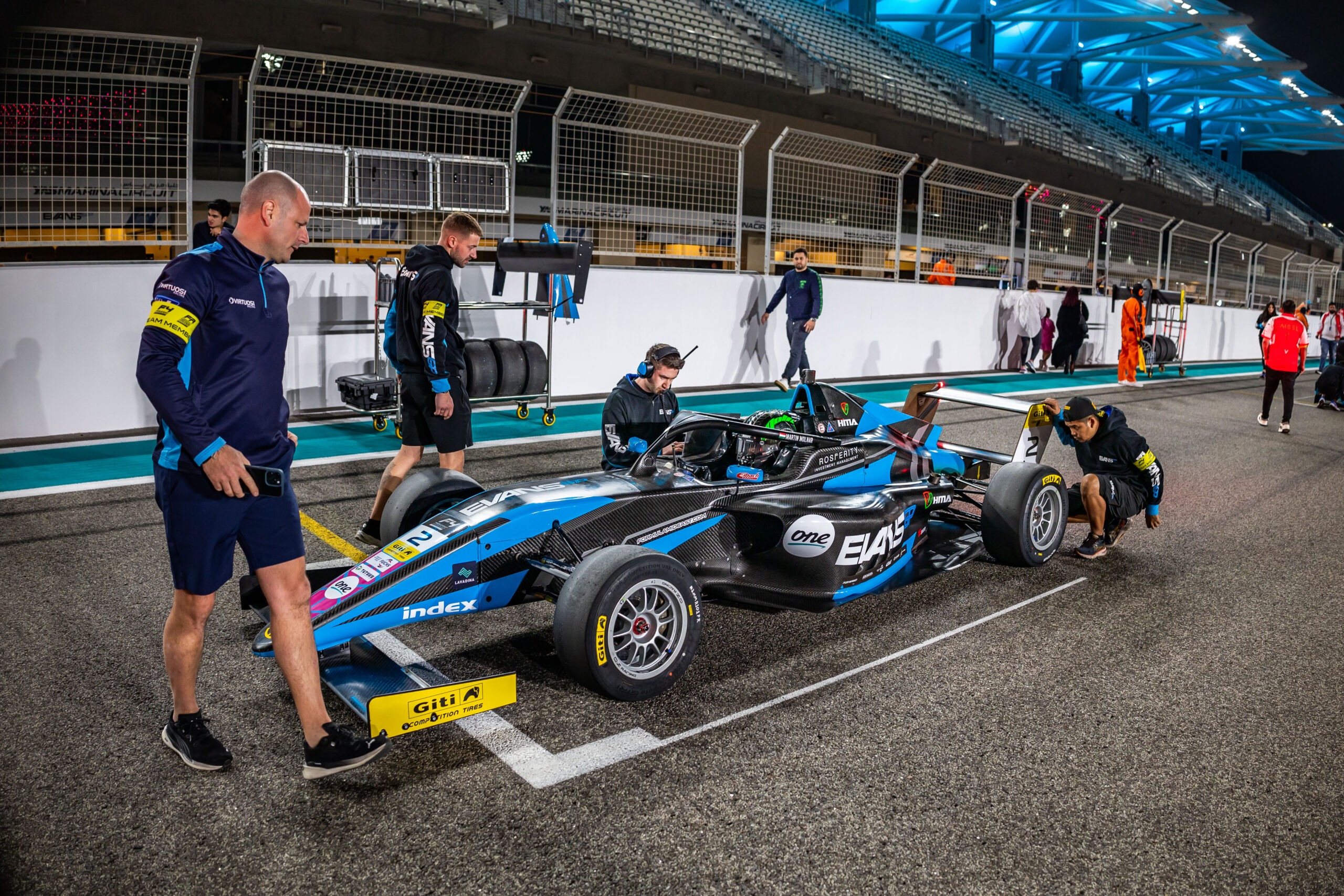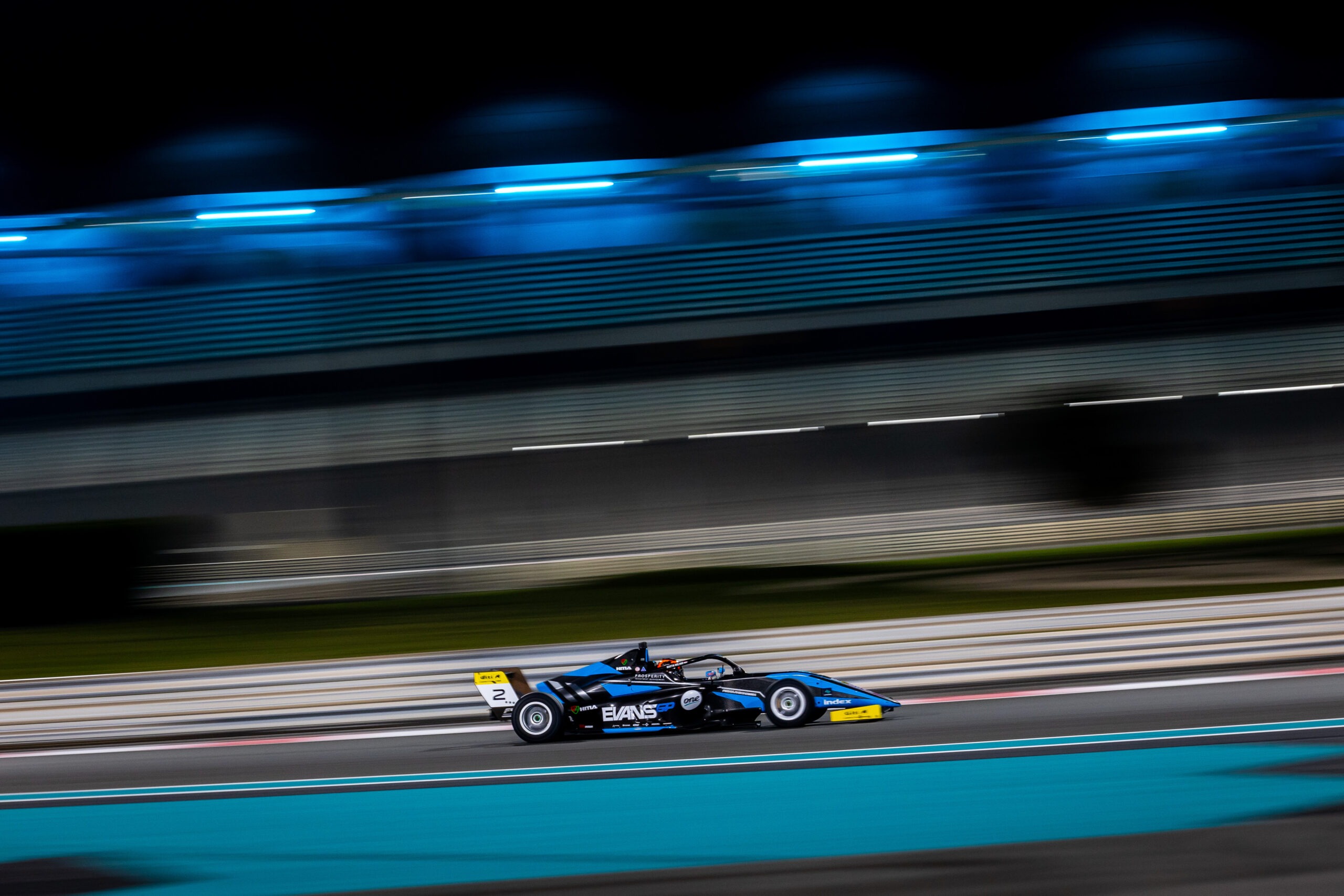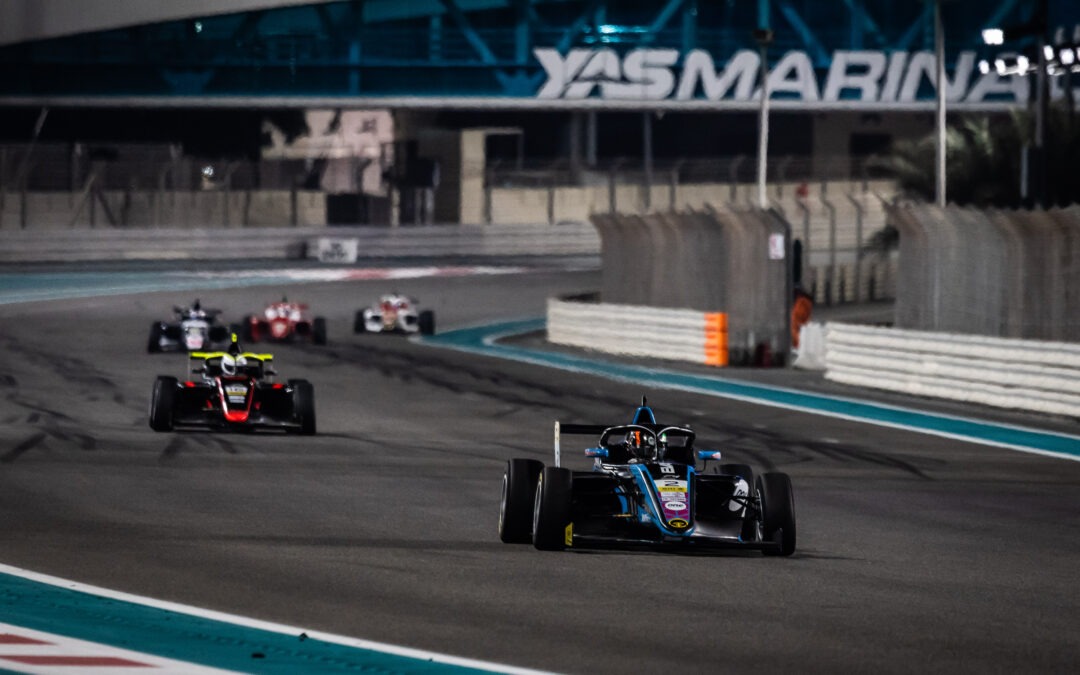Molnár Martin’s first race weekend in the F4 Middle East Championship was characterized by continuous development. The British F4 Rookie Champion from last year finished 11th in the overall standings for his team, Evans GP, after securing two top-10 results and three points scoring finishes from the three races in Abu Dhabi out of a 29-car field. Martin and his team was struggling with car setups and the Hungarian driver had to get used to completely different tires compared to what he was used to in British F4. He also faced numerous new challenges, including the new brakes, the hot weather, the circuit itself, and racing under floodlights.
The Hungarian Motorsport Academy (HMA) driver qualified 13th for the first race and 11th for the third race. However, if a few centimeters of track widening hadn’t invalidated his best lap time, he would have started the first race 8th ont he grid. In the first race he made a strong start moving up to 9th by the end of the first lap, and after a sensational double overtaking move he finished in 11th.

“The double overtaking move was definitely the highlight of my race, but my start and the first lap weren’t bad either. It would’ve been great to snatch 10th place at the end and secure the reverse grid pole position, but that didn’t happen. We’re aiming to improve the car setup for the second and third races, and I also need to focus on getting rest, as I’ll only have around five hours of sleep before Sunday’s morning race, then a 10-hour wait until the evening third race,” Martin assessed after the first race.
In the second race on Sunday morning, Martin had an even better start than in the first race. Starting 11th, he was already 8th by the end of the opening lap. His race became a rollercoaster, as he both overtook others and was overtaken. At one point, he found himself in 13th but fought back to finish in 9th.
Before the third race, which took place in the evening under floodlights, the drivers had a 10-hour rest, which posed its own challenges. However, Martin made no excuses. Starting 11th, he gained two positions off the start and eventually finished 8th, his best result so far. The only downside to the final race was the two lengthy safety car periods, which reduced the overall amount of racing time for the 28-minute plus one-lap race.
“We didn’t have the pace we wanted at the second race, but from a racing perspective, it was the best race of the weekend: my start was better than on Saturday, and I overtook multiple cars; I feel I’ve improved in that area,” Martin reflected. “For the third race we managed to improve the setup after having nothing to lose, and we went with a completely different philosophy. Even though I couldn’t do many laps in race conditions, from what we did race, it seemed that our new approach worked. From that standpoint, I’m disappointed about the two safety car periods, as we lost valuable racing time, but at least we’ll start next round with a better baseline.”

“Martin had a successful and productive first weekend in the F4 Middle East Championship, and even though his name doesn’t carry the ‘rookie’ tag, it’s important to point out that more than half of the field is competing for the second time in this championship, making them significantly more experienced than him,” noted Tamás Pál Kiss, the sports director of Motorsport Talent Management (MOTAM). “Given this, I’m absolutely satisfied; I expected Martin to be around the top 10, and considering that his best qualifying time was taken away, it’s very likely he could have finished all three races in the top 10.”
Tamás Pál Kiss was especially pleased with the weekend because it showed that the British F4 rookie champion has already made progress since his last race in 2024. “I didn’t expect Martin to immediately handle the pressure in this massive field. This championship is intense, with 29 cars on the grid, and the conditions were unfamiliar – new tires, new brakes, and after only five hours of sleep between the first and second race days, followed by a 10-hour wait between the second and third races. What reassured me was the way he handled racing, positioning, and battles. We aimed for progress after last season, and already this weekend, you could see that the experience from last year has settled in. Now he just needs to adjust to the new things, and he’s doing that. He’s adapting, learning, and while doing so, he was flawless: he didn’t go off track, didn’t make contact with anyone, and so on. He raced with discipline and showed clear development across the entire weekend, just as he did throughout last season.”
Now, Martin only has one day of rest before the F4 Middle East Championship resumes on January 21. The field will remain in Abu Dhabi, competing on a layout slightly different from the one used during the opening weekend. Qualifying will take place on Wednesday at 3:00 PM CET, while the first race will be held on Wednesday at 6:25 PM CET. The second race will take place on Thursday at 9:40 PM CET and the third on Friday at 1:10 AM CET.
“It was surprising that before the third race, the team reverted to a previously tested setup and went all-in with the strategy. This was partly due to the improving track conditions and Martin’s better understanding of the surroundings and tires. We’ve already agreed on a clear direction for next week, and on Tuesday, Martin will have two one-hour test sessions,” Tamás Pál Kiss looked ahead. He also provided insight into the tire management challenges Martin faced during the first round and will continue to encounter.
“He needs to get used to how to manage tires on a track like this, under these conditions. I spoke with him before the last race, and we went through the data, analyzing everything from a driving technique perspective. Tire management is all about feel – it’s not about thinking, for example, ‘don’t lift the throttle in the fast left-handers, and don’t drop 10 percent on the throttle.’ It’s more complex than that. It’s a feeling that comes with time, allowing you to understand the tires, the track, the cause-and-effect relationships, and ultimately how to manage the tires – when to push them and when to back off. The window for optimal speed is very narrow: push too hard, and you’ll be slow; don’t push hard enough, and you’ll be slow either This doesn’t come overnight, because although Martin already has a year of experience in British F4, he has to manage these tires completely differently.”
